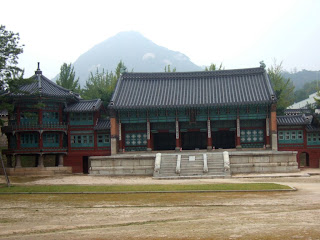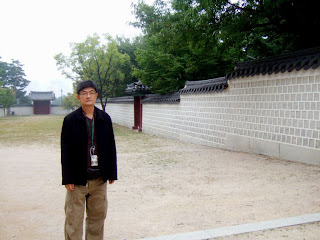
Gyeongbokgung is the symbol of majesty for Korea nation and sect of Korean royal family. The Royal Palace was one of the five palaces built in Joseon Dynasty. It was first built by King Taejo, first King of Joseon Dynasty in 1394 but reconstructed in 1867 as most of the royal buildings were burnt down during Japanese invasions of Korea (1592-98) and in early 20th century during the occupation of Japanese, 85% of reconstructed building complex was dismantled and destroyed again. Since 1990, it was slowly restored to its original from prior to destruction and 40% of the original buildings had been reconstructed by now. .


Palace Complex occupied a total land area of 46 hectares with 330 buildings and 5792 rooms. The significant Throne hall, Reception Hall and King's residence are the nucleus of the palace., forming a central axis with Gwanghwamun, the main gate.


In order to eradicate the symbol and heritage of Joseon Dynasty, Japan Government building for Governor General of Korea was built right in front of Imperial Throne Hall, Geunjeongjeon, and Gwanghwamun, the main gate was removed in 1911




The floral designed two tiers incense burner and the newly built pillars corridor.



The original flooring stone tablet and reconstructed stone wall.


Gyeonghoeru is the royal banquet hall built in 1412 and burnt down in 1592 and later reconstructed in 1867.


The two storey pavilion was an important national landmark. It was constructed with wood and stone only on an artificial pond of size 128x113 meters to hold important and special state banquets. . There are a total of 48 stone pillars and the site was depicted on Korean's 10k won note. .


The ventilators fixed on the wall were served as air-conditioner, to keep the halls cool in summer and warm in winter.



The beautiful design on windows and doors





Queen's sleeping chamber and living quarters, Gyotaejeon Hall, was behind Kings quarter Gangnyeongjeon. Both buildings were with no top roof ridge.



The current building was reconstructed in year 1994. The original was burnt down in 1592 and rebuilt in 1867 and in 1917 it was on fire and finally dissembled by Japanese and recycled the material to restore Daejojeon.




Architectural styled roofing of Joseon Dynasty.



Abundant persimmon trees at the garden field in the palace complex.






The navigation canal and the covered well which was built in 1868 to keep the clean and cool spring water for drinking purposes.



The two storey hexagon Hyangwonjeong Pavilion was built in year 1873 by King Gojong. It was situated on an artificial lake Hyangwonji and connected to Palace by Chwihyanggyo Bridge which was originally completed solely by wood, but unfortunately it was destroyed in Korean War. The present bridge was rebuilt in 1953.


Yeolsangjinwon spring water pond was a like mirror, reflecting the buildings and trees around it.


Jibokjae named as Hall of collecting Jade, was a private two storey library used by King Gojong. The 2-layers high Octagonal building, Parujeong, by its right side was meant for book storage purposes.



As at year 2009, nearly half of the reconstruction work was completed according to its original features.




There are actually less than 10 buildings are of 19th century's origins.









The palace sit right at the heart of Seoul with Mt Bugaksan to its rear and Mt Namsan in the foreground.






The Blue House called as Cheongwadae in Korean is the residence of Korean President since 1948 the independent year. It was actually site of the royal villa that built by King Sukjong in 1104 in the southern capital of Goryeo Dynasty.


The complex of buildings covered an area of 62 acres, consisting of main office hall, reception house, press hall, secretarial building and presidential residence are in Korean Traditional architectural style with some modern elements. .


The densely forested garden in front of Blue House.


The lonely protester in front of The President House.





The symbolic fountain is the landmark for Cheongwadae. Phoenix represents the head of the state while the global means world, pavilion means nation power and group statues given out the meaning of peace, harmony, united and prosperous.


The drum pavilion at Cheongwadae Srangchae, the exhibition and museum hall.







No comments:
Post a Comment